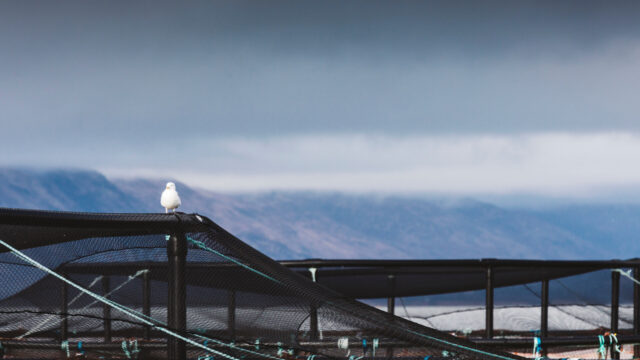
Co-existing with marine life
Our farmers have the privilege of working alongside an array of wild and wonderful marine life.

Like most food producers, we're working hard to minimise any impact from our farming activities on the seabed and surrounding marine environment.
In Scotland, any business or organisation whose activities could impact on the water system is subject to the Water Environment (Controlled Activities)(Scotland) Regulations; more commonly known as the Controlled Activity Regulations (CAR).
Under CAR, the Scottish Environmental Protection Agency (SEPA) will assess the likely risk posed by the activities before deciding if they are to be permitted and, if so, at what level.
In terms of how and where it applies to salmon farming, CAR regulates our activities in freshwater, seawater and processing.

We have three freshwater facilities: our main Barcaldine Hatchery near Oban, which is equipped with a recirculating aquaculture system, our more traditional flow-through Knock Hatchery on the Isle of Mull and a third hatchery at Girlsta on Shetland.
Each facility relies on sourcing freshwater from a nearby reservoir, river or loch then discharging used water into a nearby sea loch.
Key to both processes is that the good quality water classification of the local water body is protected.
As such, all water drawn is done so in accordance with what’s known as a water abstraction licence. Issued by SEPA, this sets maximum daily flow volumes to protect the source water body.
Similar care is taken with regards to discharging water back into local water bodies, with all our hatchery water discharged within compliance limits.

Out on a marine farm there are five key factors that determine impact on the local benthic (seabed) biology and chemistry:
Information on each factor is input into scientific modelling and used by SEPA to advise on what the local marine environment can sustain.
If SEPA decides that local marine conditions can sustain a salmon farm, it will then award that farm its own CAR licence which sets farm-specific limits on the maximum weight of fish (biomass) that may be stocked at any one time, as well as any veterinary medicines that may be used.

We have a number of measures in place to help minimise our impact on the seabed, from good animal husbandry practices to the latest advances.
These measures include but are no means limited to:
Scotland’s west coast and islands are home to several marine protected areas (MPAs); areas where important habitats and species are thriving, and where protected status has been awarded to help ensure they continue to thrive.
This protection may include restrictions on activities such as sailing, mooring, fishing, development of the area or the removal or disruption of marine life.

Almost all of Scotland’s MPAs were given their designated status long after the growth of salmon farming, proving that salmon farms and marine life can happily co-exist.
One of the most recent examples of this is the Harbour Porpoise Special Area of Conservation which was created on 22 September 2016. The largest protected area in Europe for this species, thought to cover over 5,000 porpoises, it spans 13,800km2 of the Inner Hebrides and Minches – an area with a high number of established salmon farms.
It’s further proof that, with responsible farm management and good fish husbandry, salmon farming and species of special interest can co-exist happily in the same waters.

Testament to the abundance of wildlife and marine life spotted around our farms, 2021 saw us successfully pilot and roll-out a new wildlife sightings app.
The app enables our farm teams to record sightings – from orcas and otters to sea gulls and sea eagles – via their phone or laptop, acquiring coordinates accurately from GPS signals and providing a consistent picture across all our farms.
The data collated is shared with the Biological Record Centre, which is a component of the National Biodiversity Network, meaning that it can be used by everyone from the general public, conservationists and NGOs to the wider science community.

Our commitment to safeguarding Scotland’s waters extends beyond our own farm settings. We’re also working to ensure that the cleaner fish we use are sourced in a responsible way.
All lumpsuckers that we use are now from farmed origin. Using eggs from wild-caught broodstock (parent fish) they are raised in hatcheries; a process that takes roughly one year.
In contrast, ballan wrasse – the second key species of cleaner fish that we use – take considerably longer to raise in hatcheries with females reaching sexual maturity at six years, longer for males, with offspring taking 18 months to reach the correct size for deployment in sea pens.
As such, the majority of ballan wrasse that we use are still wild-caught. In the interests of fish welfare and the environment, this is done in accordance with mandatory measures, implemented by the Scottish Government following successful piloting of voluntary measures set out by the sector itself in partnership with Marine Scotland and RSPCA Assured.
These mandatory measures ensure that:
This data tells us that wild wrasse are thriving, providing the clearest indication that they are being fished sustainably.
You can read more about the mandatory measures in place here.
Banner photo: Scalloway, Shetland, courtesy of Billy Arthur